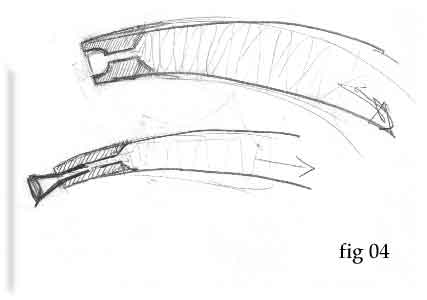|
|
|
Making a functional signal horn
Domingo de Valencia, Loch Cairn
Meridies
INTRODUCTION
| My model is commonly known as a "viking horn", the term signal horn however, is all encompassing to horns made of brass, carved wood, and animal horn. They were used to signal arrivals, locating members of hunting parties and in times of war, to signal an advance or retreat. I will begin by explaining the mechanics of the signal horn, the same applies to all horns of the brass family; medieval and modern. |
MECHANICS
| There are two vital pieces to the horn. The mouthpiece and the amplifier. By buzzing your lips (like a bee) into the mouthpiece, it directs the sound into the amplifier where the sound waves continually cross and vibrate along a path where the horn goes smallest to largest. It is this vital resonating that creates the horn sound. The bigger the amplifier the deeper the sound, and the bigger the mouthpiece that is required. A well supported breath will also add to the volume of the horn. Breathe from the diaphragm (muscle below the stomach.) |

| Mouthpieces may be attached by fitting them into a bore hole or may be carved out of the very tip of the horn itself. Though carving a mouthpiece into the horn is definately "in period" for S.C.A. purposes, you must cut the tip of the horn further, thereby leaving LESS of the amplifier portion of the horn that is used. This is why the practice of placing a mouthpiece into the bore may be substituted. |

| fig 03. The mouthpiece will dictate the higher or lower pitches. A small mouthpiece with a cup shape bowl will create a high pitched sound whereas a mouthpiece with a conical shape will produce a more mellow one. As a rule of thumb: let the mouthpiece you make (or fit in) match the horn's function, size, or desired pitch. A horn is just another horn without the mouthpiece. |
CREATING THE HORN
| The amplifier horn itself must be cleaned THOROUGHLY. If you have a horn that is well cleaned you're in good shape. Any animal matter on the inside of the horn must be cleaned out. If left in the horn, it muffles the clarity of the sound (and removal of the detritus in the horn keeps that lovely smell of dead cow out of your nostrils). By using hot water the "beef jerky" in the horn can be cooked out. At this time you will experience the smell of the dead animal. This is natural! Things that are dead smell bad. I suggest somehow doing this outside or in a well ventalated area. After filling the horn with hot water (or placing the horn in a bucket of hot water) leave it sitting over night. I used household bleach to help break down the matter, keep down the smell and help sterilize. The next day I rinsed and scrubbed the inside of the horn with a brillo pad (that comes with soap) and rinsed out all the detritus. Let the horn sit for one more day in water and bleach. |

| When it's time to create the mouthpiece to the horn cut off the tip of the horn by an inch or two. By taking a hand drill with a wood drilling bit you can determine the distance of the solid horn *THE TIP END OF THE HORN IS SOLID* this is where you drill and carve. Of course you need to cut the horn farther if you are planning to carve in a mouthpiece. Otherwise you can fit a brass (store bought) mouthpiece into an appropriately drilled bore. French horn mouthpieces work QUITE well and can be found on e-bay for a fraction of the new price. |

|
I hope that this webpage helps out! Nothing can be as attention grabbing as a signal horn. If you need help, or have questions (because much of this article is vague as it was written in haste) please e-mail me at: Domingo de Valencia
|